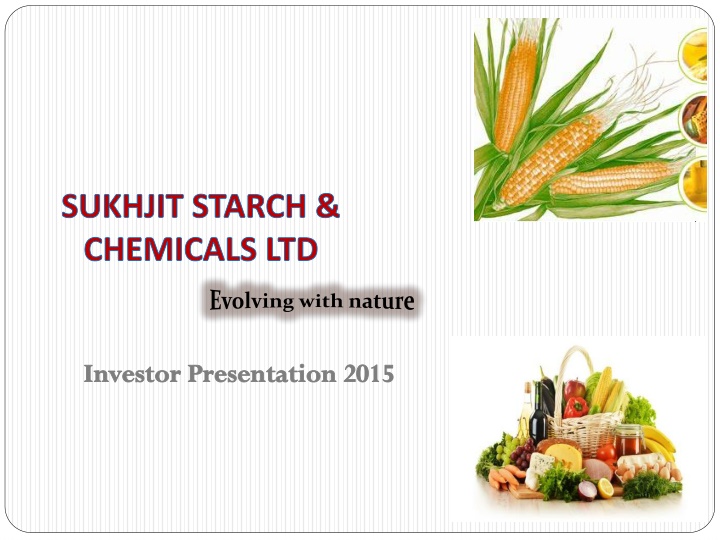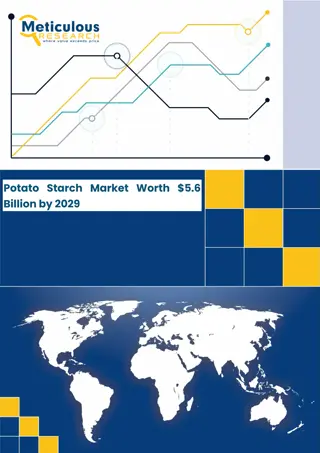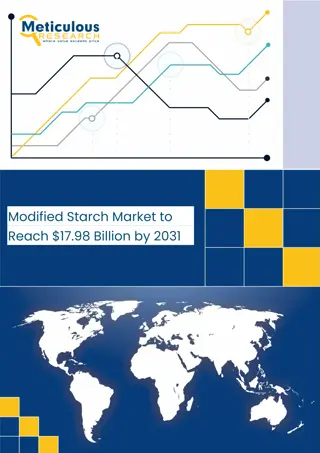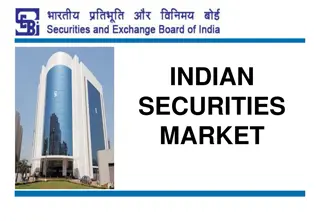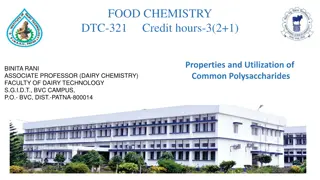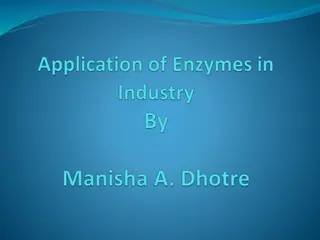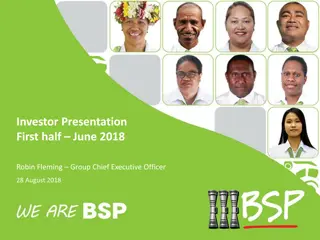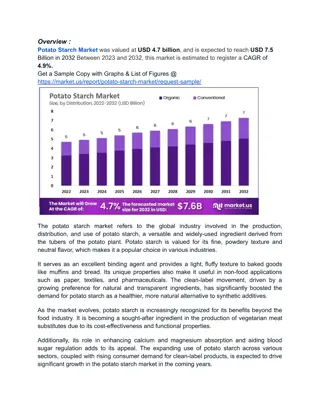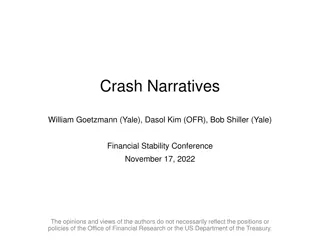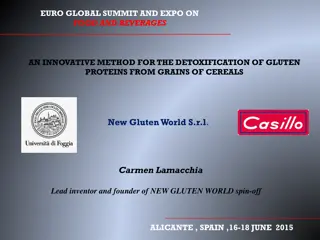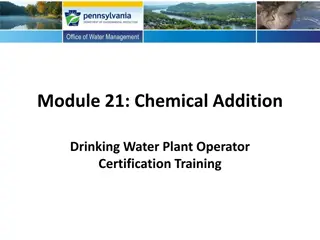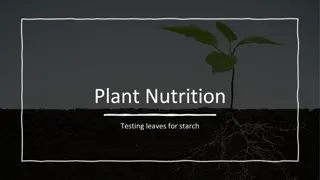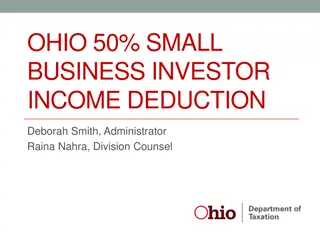Evolution of Sukhjit Starch & Chemicals Ltd - Investor Presentation 2015
Sukhjit Starch & Chemicals Ltd, a leading producer in India, highlights its business overview, product overview, management vision, industry dynamics, financial highlights, and strategic outlook in the investor presentation. With a history of consistent growth and strong management, the company has capitalized on the growth of the maize starch industry. The manufacturing process of starch industry is detailed, showcasing the steps involved from corn inspection to starch separation. The presentation also emphasizes the growing demand for modified starch in India due to changing consumer habits.
Download Presentation

Please find below an Image/Link to download the presentation.
The content on the website is provided AS IS for your information and personal use only. It may not be sold, licensed, or shared on other websites without obtaining consent from the author.If you encounter any issues during the download, it is possible that the publisher has removed the file from their server.
You are allowed to download the files provided on this website for personal or commercial use, subject to the condition that they are used lawfully. All files are the property of their respective owners.
The content on the website is provided AS IS for your information and personal use only. It may not be sold, licensed, or shared on other websites without obtaining consent from the author.
E N D
Presentation Transcript
SUKHJIT STARCH & CHEMICALS LTD Evolving with nature Investor Presentation 2015
CONTENTS 1. Business Overview 2. Product overview 3. Management Vision and Ethics 4. Industry Dynamics 5. Financial Highlights 6. Strategic Outlook
BUSINESS OVERVIEW First entry mover advantages: One of oldest producer of Starch in India and third largest in India as per production Long lasting relationship with biggest brands and end users Consistent expansion results in huge jump in capacity from 1800 TPA in 1943 to over 4 Lacs TPA in 2014-15 Diversification across customers and end-markets Strong management team with proven track record Consistent & uninterrupted dividend track record for the last four decades
MANUFACTURING PROCESS OF STARCH INDUSTRY First the incoming corn is inspected and cleaned. Then it is steeped for around 40 hours to begin breaking the starch and protein bonds. The next step in the process involves a coarse grind to separate the germ from the rest of the kernel. The remaining slurry consisting of fiber, starch, and protein is finely ground and screened to separate the fiber from the starch and protein. The starch is separated from the remaining slurry in hydrocyclones. The starch then can be converted to syrup or it can be made into several other products through a fermentation process.
PRODUCT OVERVIEW Growth of Maize Starch industry has doubled in the last 5 years in terms of grinding capacity of Maize. North America is expected to lead the global modified starch market with share of 39 percent followed by Asia-Pacific (29 percent) and Europe (27 percent) in terms of consumption. Due to opening up of the FDI in Retail sector, more international players likely to penetrate the Indian Market.
PRODUCT DEMAND OVERVIEW India with its huge population base and low consumption levels offers a massive opportunity to capture Change in Consumer behavior with respect to habits & patterns of food consumption Packaged ready-to-eat food is the order of the day due to ready OTC availability: Increase in requirements of modified and value-added starch products i.e. its derivatives, in the packaged food industry
PRODUCT DEMAND OVERVIEW High-fructose corn syrup, also high-fructose maize syrup in other countries comprises any of a group of corn syrups that has undergone enzymatic processing to convert some of its glucose into fructose to produce a desired sweetness. Beer industry substituted sugar with High Maltose Corn Syrup (HMCS) and Dextrose, both derivates of Maize Starch. Manufacturers of Aerated Drinks yet to substitute sugar with an alternative. Enquiry made by manufacturers of Aerated Drinks and Beer, as to an alternative of sugar has increased in last few years.
PRODUCT USAGE PRODUCT USER INDUSTRY STARCH TEXTILE, PAPER DEXTRINE/PRE GEL/MODIFIED STARCH FOOD, PAPER, PAINT GLUCOSE FOOD, FMCG, PHARMA SORBITOL PHARMA, PAINT, FMCG MAIZE GLUTEN/FIBRE/ GERM ANIMAL, POULTRY FEED, EDIBLE OIL
MANIPULATED CORN STARCH USAGE Extrusion, the same process used to make snack foods, can alter the physical structure of corn starch to make totally biodegradable packaging peanuts. Starch granules can be broken down into nano particles to form adhesives that can replace petroleum-based acetates and alcohols used to help laminate graphics onto cardboard and latexes used as binders in paper coatings. Corn starch combined with polymers creates a super absorbent used in disposable diapers, sanitary napkins, bandages, and baby powders, and can be used to remove water from fuels and to clean up pesticide spills. Corn starches is as raw material for the production of industrial chemicals and plastics which are today made from petroleum feed stocks. As petroleum supplies dwindle or become less reliable, the importance of an abundant source of basic industrial chemicals takes on new proportions. Corn industry scientists are at work on new systems for producing industrial necessities from the versatile corn plant.
FINANCIAL HIGHLIGHTS Net Profit (In Cr) 45 38.78 40 35 30 23.2 25 22.1 21.58 20 16.04 14.67 15 11.61 10 5 0 2009 2010 2011 2012 2013 2014 2015
FINANCIAL HIGHLIGHTS Revenue IN CR. 600 534.17 508.91 500 420.1 400 354.95 339.41 300 259.31 203.7 200 100 0 2009 2010 2011 2012 2013 2014 2015
FINANCIAL HIGHLIGHTS 20 IN % 18.6 18 16 14 12.98 12.36 12.31 12.25 12.23 11.47 12 10.14 NPM OPM 10 8 6.25 5.74 5.59 6 5.14 4.35 4 3.15 2 0 2009 2010 2011 2012 2013 2014 2015
INDUSTRY OUTLOOK India currently has installed starch capacity of 13,000 TPD ( 3 MTPA of starch production): Per capita consumption still very low: More than 1000 application in developed countries Industry is witnessing a burst in activity, leading to several projects to enhance / set up capacity and higher M&A Larger size plants are preferable to benefit from consolidated procurement and economies of scale in manufacturing. Surplus land and good location with access to key raw materials, water and power will allow for scale up Raw material is subject to price fluctuations as well as production uncertainty Analysts anticipate this consumption rate to continue in the near future and maize consumption will rise to 25.2 million ton by 2016-17E. China consumption grew by 4 times in last decade
GROWTH DRIVERS Per capita consumption : Low per capita starch consumption in India of 1.5 kg as compared to global average of 6.1 kg: of the consumption as comparison to china. Abundant availibility of maize and promoting export of value added products: Maize production is expected to increase with higher yield Food/Pharma applications: High price of sugar leading to search for its alternatives in food & beverages industry Steady requirement for glucose. Rising health consciousness among consumers leading to a higher appreciation of nutritional superiority of products using corn starch & derivatives New industrial applications: Modified starch suited for various specific applications resulting in higher efficiency and better quality of end products. E.g. application of cationic starch in paper industry is resulting in lower fiber loss, better printability, etc. Applications of PGS in drilling *New use for starch in manufacturing ethanol
STRATEGIC OUTLOOK Modified starch market will grow to $15.23 billion by 2017 with 3.2 percent CAGR during the same period. In some products, the Statutory permissible limit of usage of starch is still very low in India compared to the permissible limits in other American and European countries. Government may consider and thereby make necessary amendments in the permissible limits Increase in consumption of Maize products can check on the pricing of Sugar and Government may give incentives to starch industry in future 4 industrial sectors ( Pharma, Food and Beverages, Textile & Paper) which are demand driver for the industry are doing extremely well & expected to continue the uptrend in 2016
CHALLANGES Consumer industry suffers from fragmented supply: In spite of prices being low, consumer industry have low margins. Consistent quality of maize is not available round the year: Cost of cultivation is high and not competitive to world price Capacity to dry corn up to the level of 14% is not present which leads to wastage and loss to farmers. Post harvest losses are on a rise and quality protein is not available. Ground water level has gone down substantially Key challenge in setting up food parks lies in land acquisition Lack of agriculture sector reforms that many believe should run concurrently even as infrastructure for food processing is set up in the country
WAY FORWARD Carbohydrate-based products have the potential to improve the sustainability of natural resources, environmental quality and national security while competing economically to expand INDIA need to build Capacity dry corn and minimize loss to farmers. India need to find ways to increase Rabi corn and more focus to be given to post harvest management. R&D for quality protein is required. DHM needs to be banned and push for genetic manufacturing is required. Maize based Intercropping system is the need of the hour. Productivity needs to be increased through: seed treatment; use of disease resistant maize composites; growing early maturing hybrids; better provision of irrigation resources.
WAY FORWARD Maize Productivity needs to be increased through: seed treatment; use of disease resistant maize composites; growing early maturing hybrids; better provision of irrigation resources Globally, as the economies mature there is deceleration in demand growth for sugar and acceleration in growth in demand for starch / starch sweeteners. This structural change is yet to catch up in India, which boasts of a wider gap with per capita sugar consumption of 20 Kgs, against starch consumption of 1.5 Kgs. As the economy matures, Industry expect acceleration in the pace of growth in demand for Starch/Starch sweeteners over the next five to ten years. Product mix decisions are affected by many factors and economy of scale is a significant one From the production phase to industrial applications, starch is a perfect raw material to act as a substitute for fossil-fuel components in numerous chemical applications
MANAGEMENT VISION Quality is the life line of every business and Company committed to satisfy customers by manufacturing & supplying quality products to their entire satisfaction. Sukhjit is an innovation company : Products, technologies, processes, business models and strategies Addressing new growth areas: plans to expand strategically Capable of identifying and using breakthrough innovations New journey with 2nd generation by exploring fresh possibilities Increase portfolio of high margin value added products
MANAGEMENT ETHICS Respect for people and nature. Deeply committed to the social up-liftment and all round society welfare. Prevention of environment hazards along with the business/economic growth. Channelize youth energy for productive use.
SAFE HARBOR Some of the statements in this document that are not historical facts, are forward-looking statements. These statements entail risks and uncertainties that could cause actual events to differ materially from these forward-looking statements. These risks include, but are not limited to, the level of market demand for our product, market situation for our key inputs, market conditions that could cause our customers to reduce their spending for our products, our ability to create, acquire and build new businesses and to grow our existing businesses and other risks not specifically mentioned herein but those that are common to industry. The Company does not undertake to update these statements publicly to reflect changed eventualities.
IR contact Reach us : Mr Rishi K, Senior Director Reliant Investor Relations Consultancy research@rirc.in +91 9582111450 +91 75061 31222 +91 11 2244 4422
